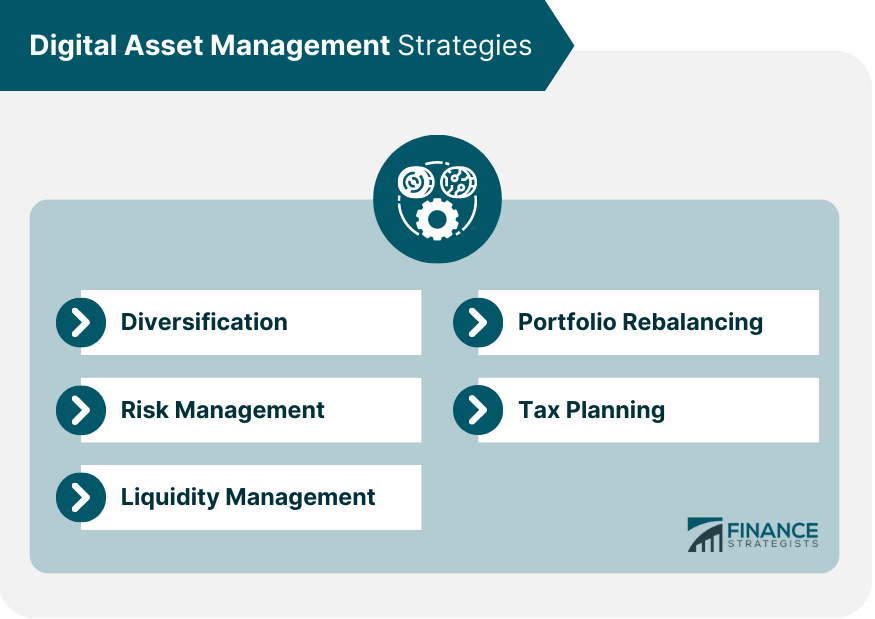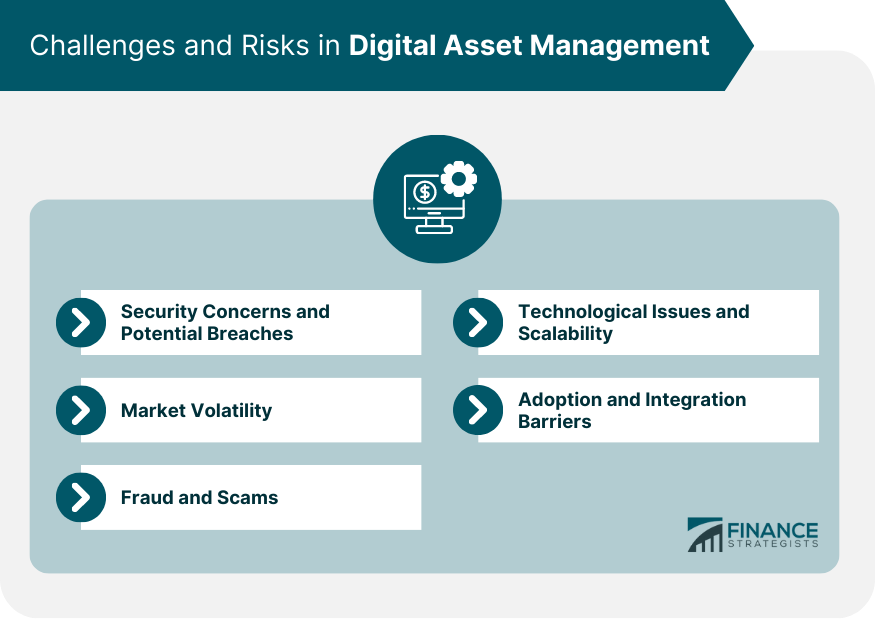Digital asset management (DAM) refers to the organization, storage, and retrieval of digital assets, such as cryptocurrencies, tokenized securities, and non-fungible tokens (NFTs), among others. In the context of finance, DAM plays a crucial role in ensuring efficient management and control of digital assets. As technology continues to evolve, digital asset management has become increasingly relevant in the financial sector, driving innovation and shaping the future of finance. Cryptocurrencies are digital or virtual currencies that utilize cryptography for secure transactions and decentralized control. Some well-known examples include Bitcoin, Ethereum, and Litecoin. Digital securities are financial instruments that represent ownership in assets or economic rights, issued and managed on a blockchain or other distributed ledger technology. These can include tokenized stocks, bonds, or real estate. Stablecoins are a type of cryptocurrency designed to minimize price volatility by pegging their value to a reserve of assets, such as fiat currencies, commodities, or other cryptocurrencies. Tokenized assets represent fractional ownership in real-world assets, such as real estate, art, or commodities, through the issuance of digital tokens on a blockchain. CBDCs are digital currencies issued by central banks, intended to function as a digital equivalent of their respective fiat currencies. NFTs are unique digital tokens that represent ownership of a specific asset or piece of content, such as digital art, collectibles, or virtual real estate. DLT refers to the decentralized record-keeping systems that underpin many digital assets, allowing for transparent and secure transactions without the need for a central authority. Consensus mechanisms are protocols that ensure agreement and validation of transactions among participants in a distributed network, such as proof-of-work, proof-of-stake, or delegated proof-of-stake. Smart contracts are self-executing contracts with the terms of the agreement directly written into computer code, which can automatically enforce and execute contract clauses when predefined conditions are met. DeFi platforms are decentralized applications built on blockchain technology that offer financial services, such as lending, borrowing, or trading, without relying on traditional financial intermediaries. Digital wallets and custodial services provide secure storage and management solutions for digital assets, enabling users to store, send, receive, and manage their assets. Asset tokenization platforms facilitate the conversion of real-world assets into digital tokens, enabling fractional ownership and the creation of new investment opportunities. Diversification involves investing in a variety of digital assets to reduce overall portfolio risk and improve potential returns. Risk management entails identifying, assessing, and mitigating risks associated with digital asset investments to minimize potential losses. Liquidity management focuses on maintaining sufficient liquidity to meet investment objectives and address market fluctuations. Portfolio rebalancing involves adjusting the allocation of assets within a portfolio to maintain the desired level of risk and return. Tax planning involves optimizing tax strategies related to digital asset investments to minimize liabilities and maximize after-tax returns. KYC and AML requirements are regulatory measures designed to prevent identity theft, financial fraud, and money laundering in the digital asset space. Digital asset managers must ensure compliance with these regulations to maintain the integrity and security of their operations. Digital asset managers need to be aware of the tax implications associated with digital asset investments, such as capital gains tax, income tax, and value-added tax, depending on the jurisdiction and specific asset type. The SEC has been actively regulating digital assets to protect investors and maintain fair, orderly, and efficient markets. Digital asset managers must adhere to SEC regulations, which may include registration, disclosure, and reporting requirements. As digital assets transcend geographical boundaries, digital asset managers must navigate complex and often inconsistent cross-border regulatory frameworks that can impact investment strategies and risk management. Digital asset managers can benefit from adopting industry self-regulation and best practices to foster trust, transparency, and accountability within the digital asset ecosystem. Digital asset managers must address security concerns related to hacking, phishing, and other cyber threats to protect investors' assets and maintain the integrity of their systems. The digital asset market is known for its price volatility, which can pose significant risks to investors. Digital asset managers must implement effective risk management strategies to navigate market fluctuations. Digital asset managers need to be vigilant about potential fraud and scams in the digital asset space, such as Ponzi schemes, pump-and-dump schemes, and fake initial coin offerings (ICOs). Digital asset managers must address technological issues and scalability concerns related to blockchain technology, which can impact the performance and efficiency of their systems. As digital assets are still relatively new and complex, digital asset managers must overcome adoption and integration barriers to effectively incorporate digital assets into traditional financial systems and investment portfolios. Digital asset management in finance has emerged as a rapidly evolving field driven by technological advancements, increasing adoption, and changing regulatory landscapes. The growing diversity of digital assets, such as cryptocurrencies, digital securities, stablecoins, tokenized assets, CBDCs, and NFTs, has created new investment opportunities and challenges for investors and asset managers alike. To effectively manage digital assets, it is essential to understand and utilize the technologies that underpin these assets, such as blockchain technology, DeFi platforms, digital wallets, and asset tokenization platforms. Adopting effective digital asset management strategies, such as diversification, risk management, liquidity management, and tax planning, can help navigate the inherent risks and complexities associated with digital asset investments. Compliance with regulatory requirements, such as KYC, AML, and SEC regulations, is crucial for maintaining trust and integrity in the digital asset ecosystem. Furthermore, addressing challenges related to security, market volatility, fraud, technology, and adoption barriers is vital for the successful integration of digital assets into the broader financial landscape. Looking ahead, the future of digital asset management is expected to be shaped by trends such as growing institutional investment, the expansion of DeFi services, increased tokenization of real-world assets, the development of CBDCs, and the integration of AI and ML technologies. As the digital asset management industry continues to mature and innovate, it will play an increasingly significant role in shaping the future of finance.What Is Digital Asset Management?
Types of Digital Assets in Finance
Cryptocurrencies
Digital Securities
Stablecoins
Tokenized Assets
Central Bank Digital Currencies (CBDCs)
Non-fungible Tokens (NFTs)
Digital Asset Management Technologies
Blockchain Technology
Distributed Ledger Technology (DLT)
Consensus Mechanisms
Smart Contracts
Decentralized Finance (DeFi) Platforms
Digital Wallets and Custodial Services
Asset Tokenization Platforms
Digital Asset Management Strategies
Diversification
Risk Management
Liquidity Management
Portfolio Rebalancing
Tax Planning

Regulatory and Compliance Issues in Digital Asset Management
Know Your Customer (KYC) and Anti-money Laundering (AML) Requirements
Tax Implications
Securities and Exchange Commission (SEC) Regulations
Cross-Border Regulatory Challenges
Industry Self-Regulation and Best Practices
Challenges and Risks in Digital Asset Management
Security Concerns and Potential Breaches
Market Volatility
Fraud and Scams
Technological Issues and Scalability
Adoption and Integration Barriers

Conclusion
Digital Asset Management FAQs
Digital asset management refers to the process of managing digital assets such as cryptocurrencies, tokens, and digital securities. It involves the safekeeping, tracking, and reporting of these assets to ensure their value is preserved and they can be easily traded or transferred.
Digital asset management is important in finance because it allows investors to diversify their portfolio and gain exposure to emerging asset classes like cryptocurrencies. It also provides a secure way to store and manage these assets, minimizing the risk of loss or theft.
One of the biggest challenges associated with digital asset management is the lack of standardization and regulation in the industry. This can make it difficult to determine the true value of digital assets and assess their risk. Another challenge is the risk of cybersecurity threats, which can result in loss or theft of assets.
There are several tools used in digital asset management, including cryptocurrency wallets, exchanges, and trading platforms. These tools allow investors to buy, sell, and store digital assets, as well as track their value over time. Some digital asset management platforms also offer additional features such as automated trading and portfolio management.
Investors can ensure the security of their digital assets by using reputable digital asset management platforms and following best practices for cybersecurity. This includes using strong passwords, enabling two-factor authentication, and storing assets in offline, cold storage wallets. It's also important to stay up to date on the latest security threats and vulnerabilities in the digital asset space.
True Tamplin is a published author, public speaker, CEO of UpDigital, and founder of Finance Strategists.
True is a Certified Educator in Personal Finance (CEPF®), author of The Handy Financial Ratios Guide, a member of the Society for Advancing Business Editing and Writing, contributes to his financial education site, Finance Strategists, and has spoken to various financial communities such as the CFA Institute, as well as university students like his Alma mater, Biola University, where he received a bachelor of science in business and data analytics.
To learn more about True, visit his personal website or view his author profiles on Amazon, Nasdaq and Forbes.











